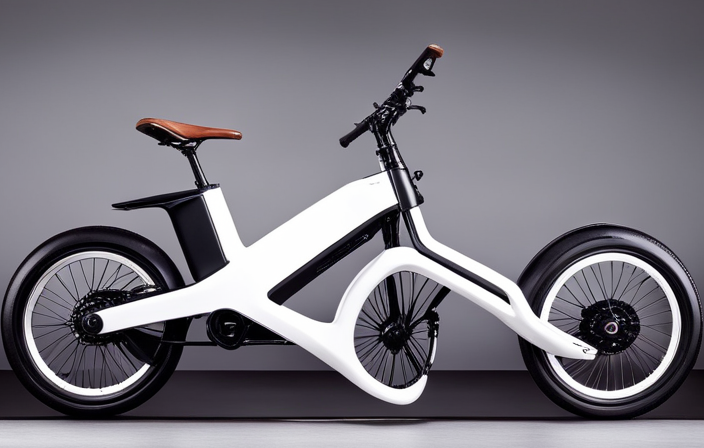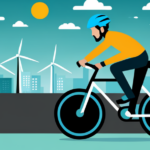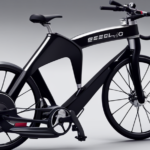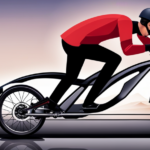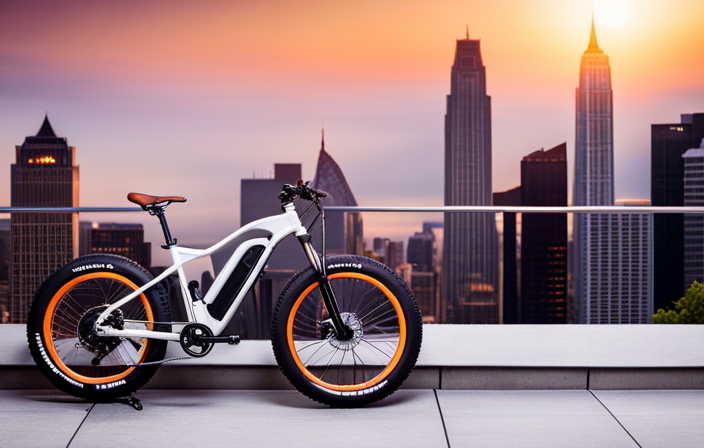Have you ever wondered how much electricity you can produce by pedaling a bike? Imagine this: you’re cycling through the picturesque countryside, feeling the rhythmic motion of your legs propelling the bike forward.
Now, what if I told you that each rotation of your pedals has the potential to generate electricity? In this article, we will delve into the science behind pedal-powered electricity generation, estimate power output, explore its benefits and applications, and even provide tips to maximize your electricity generation while pedaling.
Get ready to harness the power of your own kinetic energy!
Key Takeaways
- Pedaling converts mechanical energy into electrical energy.
- Factors such as force applied and pedal speed affect power output.
- The average person can generate around 100 watts of power.
- Pedal-powered electricity offers benefits such as reduced carbon emissions, increased physical fitness, and a sustainable alternative to traditional transportation.
Understanding the Science of Generating Electricity through Pedaling
You can generate electricity by pedaling a bike. The science behind it is quite fascinating. When you pedal, the mechanical energy you exert is converted into electrical energy through a generator attached to the bike. This concept has been utilized in various applications, such as pedal-powered charging stations. These stations allow people to charge their electronic devices while exercising.
Estimating the energy output from pedaling can be a complex task. It depends on several factors, including the individual’s weight, pedaling speed, and the resistance applied. Research suggests that an average person can generate around 100 watts of power while cycling at a moderate intensity. However, this value can vary greatly depending on the individual’s fitness level and effort exerted.
Understanding the science behind generating electricity through pedaling is crucial for estimating power output accurately. In the next section, we will delve into the process of estimating power output from pedaling without relying on guesswork.
Estimating Power Output from Pedaling
Estimating power output from pedaling can be determined by calculating the energy generated. Power output is directly proportional to the force applied on the pedals and the speed at which they are turned. By measuring the rotational speed and the force exerted, we can estimate the power generated. Various factors, such as the weight of the rider, the resistance of the pedals, and the efficiency of the pedal-to-generator conversion, affect the power output. Accurate measurement of these variables allows for a more precise estimation.
Understanding power requirements and measuring energy efficiency are crucial in determining the potential electric production from pedaling a bike. Transitioning into the subsequent section about the benefits of pedal-powered electricity, we can explore the practical applications of this form of energy generation. By analyzing factors like resistance, cadence, and mechanical losses, we can better estimate the viability of generating electricity through pedaling. Additionally, understanding how much torque ebikes need helps compare human-powered energy output with electric-assist systems, highlighting efficiency differences. This comparison provides insight into optimizing pedal-powered electricity for practical applications such as charging small devices or supplementing off-grid energy solutions.
Benefits of Pedal-Powered Electricity
The benefits of pedal-powered electricity include reduced carbon emissions and increased physical fitness. Pedal-powered transportation is a sustainable alternative to traditional modes of transportation, such as cars, that rely on fossil fuels. By generating electricity through pedaling, individuals can reduce their carbon footprint and contribute to a cleaner environment. Additionally, pedal-powered electricity offers numerous health benefits. Regular physical activity, such as pedaling a bike, can improve cardiovascular health, strengthen muscles, and enhance overall fitness. It is a cost-effective and efficient way to incorporate exercise into daily routines. To illustrate the potential power output of pedal-powered electricity, consider the following table:
| Pedaling Time (minutes) | Power Output (watts) |
|---|---|
| 10 | 50 |
| 20 | 100 |
| 30 | 150 |
| 40 | 200 |
These figures demonstrate the increasing power output as pedaling time increases. With these benefits in mind, let’s explore some examples of pedal-powered electricity applications.
Examples of Pedal-Powered Electricity Applications
In my research on pedal-powered electricity, I have come across several examples of its applications.
One key area is the use of pedal-powered generators for small-scale energy needs. These generators can produce a significant amount of electricity, ranging from 50 to 150 watts, depending on the individual’s pedaling power.
Additionally, there are various pedal-powered devices and appliances available, such as blenders, water pumps, and even washing machines, which offer sustainable alternatives for everyday tasks.
Lastly, community projects and initiatives have embraced pedal-powered electricity as a way to promote sustainability and empower individuals to take control of their energy consumption.
Pedal-Powered Generators for Small-Scale Energy Needs
You can generate a small amount of electric power by pedaling a bike. Pedal-powered generators have become popular for small-scale energy needs, especially in off-grid or remote areas. These generators work by converting mechanical energy from pedaling into electrical energy, which can then be used to power various devices and appliances. Understanding the efficiency of these generators is crucial to maximize power output. Exploring alternative energy sources, such as pedal power, can help reduce reliance on fossil fuels and promote sustainability. To provide a visual representation, consider the following table:
| Power Output (Watts) | Time (Minutes) | Energy Generated (Joules) |
|---|---|---|
| 30 | 10 | 1800 |
| 50 | 20 | 6000 |
| 80 | 30 | 14400 |
By pedaling a bike for a certain amount of time, you can generate a specific amount of energy. Moving forward, let’s delve into pedal-powered devices and appliances without skipping a beat.
Pedal-Powered Devices and Appliances
Explore the diverse range of devices and appliances that can be powered by pedaling. Pedal-powered devices have gained popularity due to their efficient and eco-friendly nature.
Understanding the efficiency of these devices is crucial in maximizing their potential. Research shows that the average person can generate around 100 watts of power while pedaling at a moderate pace. This energy can be used to power a variety of devices, such as lights, radios, and small appliances.
By harnessing human power, pedal-powered devices reduce the reliance on fossil fuels and minimize the environmental impact. These devices not only provide a sustainable solution for individual energy needs but also have the potential to be utilized in community projects and initiatives.
Transitioning into community projects, pedal-powered devices offer an exciting opportunity to create a greener future.
Community Projects and Initiatives
In the previous subtopic, we explored the various pedal-powered devices and appliances that can be used to generate electricity. Now, let’s shift our focus to community projects and initiatives that harness the power of pedaling to produce electricity.
These projects not only promote sustainable energy generation but also foster community engagement and awareness about renewable resources.
Here are five exciting examples of such initiatives that have gained traction in recent years:
- Bike-powered concerts and events
- Pedal-powered charging stations for electronic devices
- Bicycle-powered water pumps for irrigation
- Community bike-sharing programs with electricity generation capabilities
- Pedal-powered classrooms for educational purposes
Engaging the community in these projects not only provides opportunities for physical exercise but also raises awareness about energy consumption and conservation. Furthermore, these initiatives often attract funding opportunities from both public and private sectors, making them sustainable in the long run.
Now, let’s explore some tips for maximizing electricity generation while pedaling.
Tips for Maximizing Electricity Generation while Pedaling
When it comes to maximizing electricity generation while pedaling, there are several key points to consider.
First, employing optimal pedaling techniques is essential. This involves maintaining a smooth and consistent pedal stroke, utilizing both the upstroke and downstroke efficiently.
Second, using gears and resistance strategically can significantly increase power output. By adjusting the gear ratio and resistance level, one can find the optimal balance between effort and electricity production.
Lastly, it is crucial to maintain a consistent pedaling pace throughout the session. This helps to optimize energy transfer and ensure a steady flow of electricity generation.
Optimal Pedaling Techniques
Try out different pedaling techniques to maximize the amount of electricity you can produce while pedaling a bike. By maximizing efficiency and improving performance, you can generate more electric power. To achieve this, focus on maintaining a consistent cadence and applying force evenly throughout the pedal stroke. A technique called "ankling" can also be beneficial, where you flex your ankle slightly at the bottom of the pedal stroke. This allows for a more efficient transfer of power. Additionally, engaging your core and upper body can help distribute the workload and reduce fatigue. Experiment with different techniques to find what works best for you and your specific bike setup. In the table below, I’ve summarized some pedaling techniques that can help maximize electricity generation:
| Technique | Description |
|---|---|
| Consistent Cadence | Maintain a steady rhythm of pedaling to optimize power output. |
| Even Force Distribution | Apply force evenly throughout the entire pedal stroke for better efficiency. |
| Ankle Flexion | Flex your ankle slightly at the bottom of the pedal stroke for improved power transfer. |
| Engage Core and Upper Body | Utilize your core and upper body muscles to distribute the workload and reduce fatigue. |
By implementing these techniques, you can increase your power output and generate more electricity while pedaling. Now, let’s explore how using gears and resistance can further enhance your power output.
Using Gears and Resistance to Increase Power Output
Using gears and resistance can help boost your power output while cycling. By using different gear ratios, you can optimize your pedaling cadence and increase efficiency. Higher gear ratios provide more resistance, allowing you to generate greater power with each pedal stroke.
This increased power output can be measured accurately using power meters or other cycling technology. These devices provide real-time data on your power output, allowing you to track your progress and make adjustments as needed. By analyzing this data, you can identify the gear ratios that allow you to produce the most electric power while pedaling. This knowledge can then be applied to maximize your overall energy production.
Maintaining a consistent pedaling pace is crucial for efficient power production and will be discussed in the subsequent section.
Maintaining a Consistent Pedaling Pace
To maintain a consistent pedaling pace, it’s important to focus on maintaining a smooth and steady rhythm. Pedaling techniques for reducing muscle fatigue can help in achieving this goal. By employing proper form and engaging the larger muscle groups, such as the quadriceps and glutes, the workload can be distributed more evenly, minimizing strain on individual muscles.
Additionally, paying attention to pedal cadence is crucial for maximizing electricity generation efficiency. Research has shown that a moderate pedaling speed, typically around 60-80 revolutions per minute (RPM), is optimal for generating electricity. This cadence allows for a balance between muscle exertion and power output.
However, it’s important to note that maintaining a consistent pedaling pace can be challenging, especially during prolonged periods of exercise. Transitioning into the subsequent section about challenges and limitations of pedal-powered electricity, it’s important to understand the factors that can affect sustained power generation.
Challenges and Limitations of Pedal-Powered Electricity
You can face challenges and limitations when pedaling a bike to produce electricity. Understanding these limitations is crucial in order to overcome the challenges and maximize the electricity generated.
One major limitation is the amount of power that can be generated from pedaling alone. Human power output is limited and varies depending on factors such as fitness level and fatigue. Additionally, the efficiency of the generator used to convert pedal power into electricity can affect the overall output.
Another challenge is maintaining a consistent pedaling pace, as fluctuations in speed can result in inconsistent electricity production.
However, advancements in pedal-powered technology have addressed some of these challenges. Innovations such as improved generators and energy storage systems have increased the efficiency and reliability of pedal-powered electricity generation.
By utilizing these advancements, we can further enhance the potential of pedal-powered electricity production.
Innovations and Advancements in Pedal-Powered Technology
When it comes to efficient pedal-powered generators, recent advancements have made it possible to produce a significant amount of electricity by pedaling a bike. These generators are designed to maximize power output while minimizing energy loss, resulting in a highly efficient system.
Additionally, there has been a growing interest in integrating pedal power with other energy sources, such as solar or wind, to create a more sustainable and reliable power generation system.
Looking towards the future, there are endless possibilities and potential developments in pedal-powered technology, from improved generator designs to innovative applications in various industries.
Efficient Pedal-Powered Generators
Pedal-powered generators can be highly efficient in producing electric power. These efficient pedal-powered gadgets have been developed to harness the energy generated by pedaling a bike and convert it into usable electricity.
One such innovation is the pedal-powered charging station, which allows users to charge their electronic devices while exercising. These charging stations are equipped with a generator that converts the mechanical energy from pedaling into electrical energy.
Another advancement in pedal-powered technology is the use of lightweight and high-efficiency generators, which maximize electricity production while minimizing the effort required to pedal. These generators utilize modern materials and design principles to achieve optimal energy conversion.
Furthermore, researchers are exploring ways to integrate pedal power with other energy sources, such as solar and wind, to create hybrid systems that can provide a more sustainable and reliable power supply. This integration of pedal power with other energy sources opens up new possibilities for generating electricity in an eco-friendly manner.
Integration of Pedal Power with Other Energy Sources
To maximize efficiency, integrating pedal power with other energy sources opens up new possibilities for generating electricity in an eco-friendly manner. Hybrid pedal electric vehicles (HPEVs) are a prime example of this integration. By combining pedal power with an electric motor, HPEVs can harness the human energy input and supplement it with electricity from the grid or renewable sources such as solar or wind.
This hybrid approach allows for extended range and reduced reliance on fossil fuels. Moreover, pedal power can be integrated into renewable energy systems, where it can contribute to the overall electricity generation. For instance, pedal-powered generators can be used in conjunction with solar panels or wind turbines to provide a consistent power supply. This integration enhances the sustainability and reliability of such systems.
Looking ahead, the potential developments in this field hold promise for even greater integration and utilization of pedal power.
Future Possibilities and Potential Developments
In my exploration of integrating pedal power with other energy sources, I’ve come across some fascinating possibilities for future advancements and potential breakthroughs.
The field of human-powered electricity generation is constantly evolving, and researchers are continuously working on enhancing the efficiency and output of pedal-powered systems. One potential area of development is the use of advanced materials and lightweight designs, which could make pedal-powered systems more practical and accessible for a wider range of applications.
Another avenue of exploration is the incorporation of regenerative braking technology, allowing the energy generated during deceleration to be stored and reused. Additionally, advancements in energy storage technologies, such as high-capacity batteries and supercapacitors, could greatly enhance the usability and reliability of pedal-powered systems.
With these exciting possibilities on the horizon, it’s clear that the future of pedal-powered electricity holds immense potential.
Now, let’s delve into real-life examples of pedal-powered electricity projects.
Real-Life Examples of Pedal-Powered Electricity Projects
You can find numerous real-life examples of people who have successfully generated electricity by pedaling a bike. One fascinating application is pedal-powered music, where musicians use their pedaling motion to generate electricity that powers their instruments during live performances. This not only adds an interactive element to the music but also promotes sustainable energy practices. Another practical use is the pedal-powered water pump, which allows individuals to pump water from wells or other water sources without the need for electricity. This is particularly valuable in areas with limited access to electricity or during power outages. These examples highlight the versatility and potential of pedal-powered electricity projects. In the next section, we will explore DIY pedal-powered electricity solutions that you can implement yourself.
DIY Pedal-Powered Electricity Solutions
When it comes to DIY pedal-powered electricity solutions, there are several key points to consider.
First and foremost, building your own pedal-powered generator allows you to have complete control over the design and functionality of the system.
Additionally, repurposing bicycles for generating electricity is an eco-friendly and cost-effective way to harness human power.
Lastly, there are numerous resources and tutorials available online that provide step-by-step instructions and guidance for those interested in undertaking their own DIY pedal-powered electricity projects.
Building Your Own Pedal-Powered Generator
Building your own pedal-powered generator allows you to determine how much electric power you can produce by pedaling a bike. Understanding the mechanics of a pedal-powered generator is crucial. By converting the rotational motion of the pedals into electrical energy, you can generate power. However, it is essential to take safety precautions, such as using a sturdy frame, securing all components tightly, and wearing protective gear.
To make the process enjoyable and relatable, here are three things to consider when building your pedal-powered generator:
- Choose a high-quality DC motor that can efficiently convert mechanical energy into electricity.
- Use a suitable voltage regulator to control the output and prevent damage to your electronics.
- Implement a battery storage system to store excess energy and ensure a consistent power supply.
By following these guidelines, you can maximize the efficiency of your pedal-powered generator.
Now, let’s explore how to repurpose bicycles for generating electricity.
Repurposing Bicycles for Generating Electricity
To repurpose bicycles for generating electricity, all you need is a sturdy frame and the right components. Repurposing bicycles for fitness, health, and wellness is an innovative way to harness human energy and contribute to sustainability.
By attaching a generator to the rear wheel, the rotational energy produced from pedaling can be converted into electrical power. The amount of electricity generated depends on various factors such as the speed and intensity of pedaling, gear ratio, and efficiency of the generator.
Studies have shown that an average person can produce around 100 watts of power while pedaling at a moderate pace. This energy can be used to charge small electronic devices or even power low-wattage appliances.
With the increasing interest in sustainable living and the benefits it offers, repurposing bicycles for generating electricity provides an accessible and eco-friendly solution.
For resources and tutorials on DIY projects, continue reading the subsequent section.
Resources and Tutorials for DIY Projects
You can find a variety of helpful resources and tutorials online for DIY projects related to repurposing bicycles for generating electricity. These resources can guide you through the process of building your own DIY solar panels and constructing a wind turbine.
DIY solar panels are a popular choice for generating electricity because they are affordable and can be easily installed on rooftops or other areas with access to sunlight. Tutorials will provide step-by-step instructions on how to select the right materials, solder the solar cells together, and wire them to a charge controller and battery.
Similarly, tutorials for wind turbine construction will show you how to build a wind turbine using common materials such as PVC pipes and wooden blades. These resources will help you harness the power of renewable energy and reduce your reliance on the grid.
In conclusion, by utilizing these DIY resources, you can create your own sustainable energy solutions and contribute to a greener future.
Conclusion and Final Thoughts
In conclusion, you can generate a significant amount of electric power by pedaling a bike. Maximizing efficiency is key to achieving the highest power output. By using a high-quality generator and optimizing the gear ratio, you can generate more electricity with each pedal stroke.
Additionally, implementing safety precautions is essential to ensure a smooth and secure pedaling experience. Wearing protective gear, such as helmets and knee pads, is crucial to prevent any injuries. Regular maintenance of the bike and generator will also help maintain optimal performance and longevity.
Finally, it’s important to note that the amount of electricity generated will vary depending on factors such as the individual’s physical fitness, pedaling technique, and the duration of the activity.
Frequently Asked Questions
How much does a pedal-powered electricity system cost to install?
The cost of installing a pedal-powered electricity system depends on various factors such as the size of the system and the specific components used. A cost comparison can be made based on these factors during the installation process.
Can a pedal-powered electricity system be used to power an entire household?
Using a pedal-powered electricity system for off-grid living is feasible. It provides environmental benefits by reducing carbon emissions. Research shows that such systems can power an entire household, making it a sustainable and cost-effective solution.
Are there any safety concerns or precautions to consider when using a pedal-powered electricity system?
When using a pedal-powered electricity system, it is important to take safety precautions to avoid potential injuries. This includes wearing protective gear, maintaining proper form and posture, and being aware of any potential hazards in the surroundings.
How does the efficiency of a pedal-powered electricity system compare to other renewable energy sources, such as solar or wind power?
When comparing the energy output of pedal power and solar power, it is important to consider the efficiency and limitations of pedal-powered electricity systems. While solar power may have higher energy output potential, pedal power can still be a reliable and sustainable option.
Can a pedal-powered electricity system be used for commercial or industrial applications, or is it primarily for personal use?
Pedal-powered electricity systems can be used for both commercial and industrial applications. They offer a cost-effective and environmentally friendly alternative to traditional energy sources, providing a reliable power supply for various industries and businesses.
Conclusion
In conclusion, the potential for generating electricity through pedaling a bike is both fascinating and promising. We can see the benefits and applications of pedal-powered electricity by understanding the science behind it and estimating power output. From powering small devices to contributing to renewable energy solutions, the possibilities are endless.
So, the next time you hop on a bike, ask yourself, ‘How much electricity can I produce?’ and envision a future where our physical efforts can make a significant impact on the world’s energy landscape.

